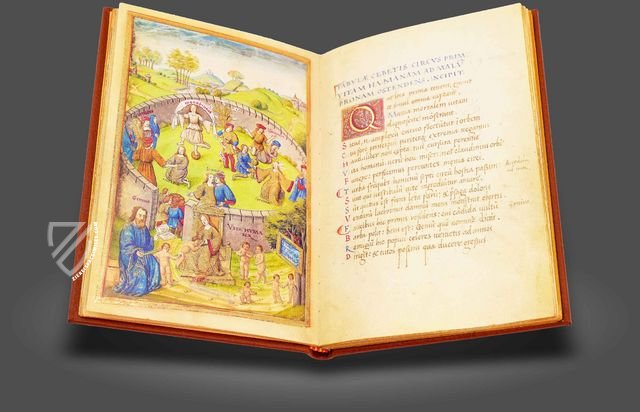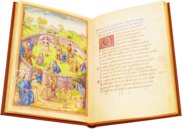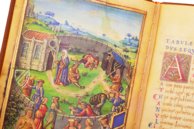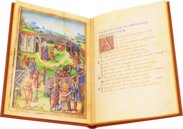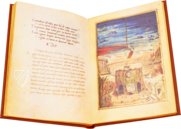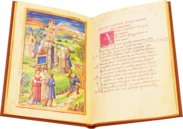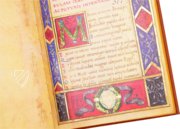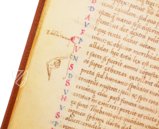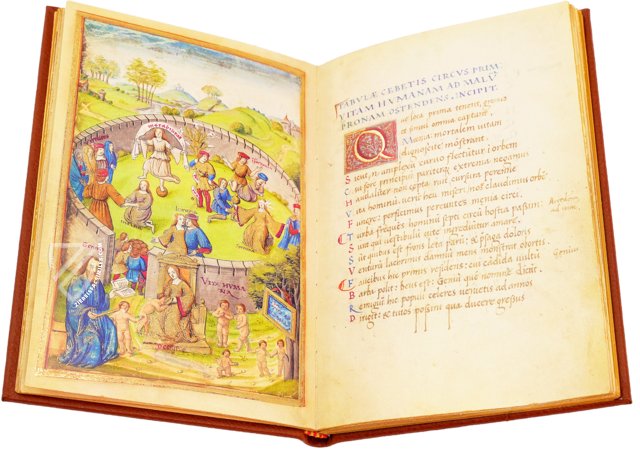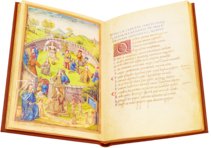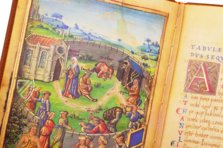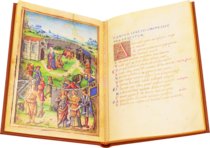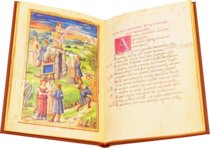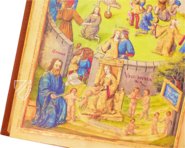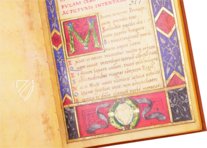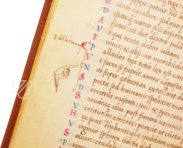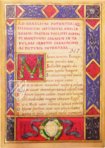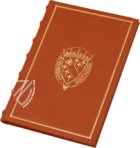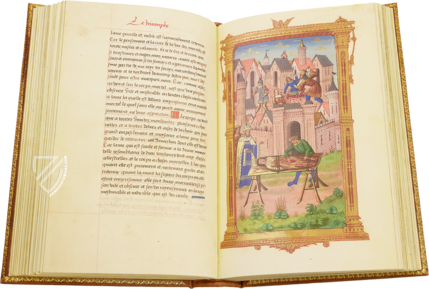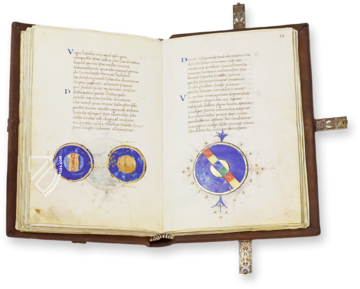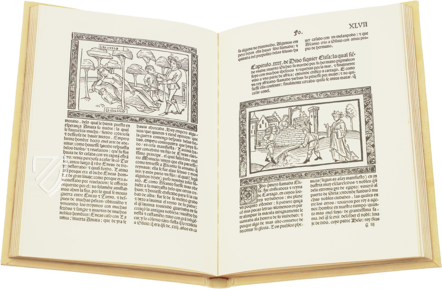Tabula of Cebes
Filippo Alberici's Tabula Cebetis is not only a wonderful gem in the British Library's Arundel Collection, but also a magnificent testimony to the radiance with which the humanist spirit of the Italian Renaissance spread throughout Europe around 1500. Alberici translated the ancient Tabula of Cebes about the turmoil of human life on the path to felicity into Latin hexameters, which Jean Coene IV illuminated with six gold-decorated, full-page miniatures. Alberici dedicated the work, written in his own hand, to the English King Henry VII, at whose court in Cambridge he hoped to be employed. However, a trip to England was unsuccessful, but resulted in several artful additions to the manuscript, including a text on 'how to die well'. The gripping story of its creation makes this little cimelia, whose content and pictorial decoration alone are intriguing, all the more appealing.
Tabula of Cebes
Around the 2nd century AD, a work known as the Kébetos Pínax (Tabula of Cebes), formerly attributed to the Socratic disciple Cebes of Thebes, literally paints a picture with words: An elderly man explains to some strangers an allegorical painting on the walls of an ancient temple of Kronos. The painting shows the human path of life, which is led down crooked paths by numerous distractions in the form of vices, bad behavior, but also false education and the pursuit of external happiness. The goal of life, however, is the achievement of felicity through true education and the striving for virtue.
A Humanist Adaptation of the Ancient " Allegory of Life"
In 1506, this Greek text was adapted by the Mantuan humanist Filippo Alberici, who was in Paris at the time. He translated Cebes' work into Latin hexameters and had the text, which he had put on paper himself, illuminated with six full-page miniatures by the Parisian illuminator Jean Coene IV (active around 1500). The resulting small manuscript Tabula Cebetis was intended to be an ornate demonstration of his talent, as he hoped to obtain an employment at the court of the English King Henry VII (1491–1547) with it as a gift. To this end, he preceded the Tabula with a Dedication to the King and traveled to Cambridge in the summer of 1507.
Dashed Hopes of a Widely Traveled Artist
However, a royal audience was probably never granted, so that Alberici's hopes were quickly dashed. Thereupon he added another poem of praise for Henry VII as well as his own work De mortis effectibus (On Dying Well). The latter 'completes' the content of the ancient work with advices for a good end of life (according to Christian ideas). Alberici also had an illuminator from Cambridge add a further miniature to this text, which is stylistically based on those of Coene. Finally, he assigned this gradually developed and therefore all the more captivating manuscript to Joachim Bretoner, the seneschal of King's Hall.
A Royal Owner
In 1608, Elizabeth Stuart (1596–1662), daughter of King James I, appears as the next owner, who entered a note with her name and date on one of the back pages of the manuscript. Via the Earl of Totnes, George Carew (1555–1629), the codex finally came to Thomas Howard (1585–1646), the founder of the famous Arundel Library, most of which is now kept in the British Library, where the autograph is located today.
Allegorical Illuminations
Jean Coene IV, who had previously worked for the French royal family, provided Alberici's Tabula Cebetis with six wonderful illuminations, which visualize the text for the reader in an exquisite palette of colours. The full-page miniatures introduce the respective sections, beginning with the scene in front of the ** temple of Kronos**. This is followed by depictions of the three rings of human life with all their personified confusions and distractions, a picture of the gate of true education leading to the garden of felicity shown in the sixth miniature. The gold-decorated images are complemented by magnificent borders and elegant initials and complete this impressive manuscript, which is an artistic testimony to the radiance with which the humanist spirit of the Italian Renaissance spread throughout Europe around 1500.
Codicology
- Alternative Titles
- Tabula Cebetis
Kebetos Pinax
Table of Cebes
Bildtafel des Kebes
De mortis effectibus
Le Tavole della Saggezza e della Virtù - Size / Format
- 60 pages / 20.5 × 14.0 cm
- Origin
- France
- Date
- 1506–1507
- Epochs
- Style
- Genre
- Language
- Script
- Humanistic Cursive Square Capitals
- Illustrations
- 7 full-page miniatures, 9 decorated initials, 2 elaborate borders
- Content
- Poem in honor of the English King Henry II about an imaginary painting and a poem about the inevitability of death ("De mortis")
- Artist / School
- Jean Coene IV (illuminator)
Filippo Alberici (scribe and author) - Previous Owners
- Joachim Bretoner; Elizabeth Stuart, Electress of the Palatinate and Queen of Bohemia; Thomas Howard, Earl of Arundel; Henry Howard, Duke of Norfolk; Royal Society (Great Britain); British Museum
Tabula of Cebes
The Beginning of the Human Path of Life
Before people enter the first ring of life, they appear symbolically as naked, innocent and unwitting children. With a wooden spoon, they are first given advice by Genius, who is depicted as an old man with a book. Opposite him, Deceptio, the deception, is already waiting, offering the children a tasty potion in a golden vessel, which, however, makes them forget all of Genius' wise counsel for their future path through life.
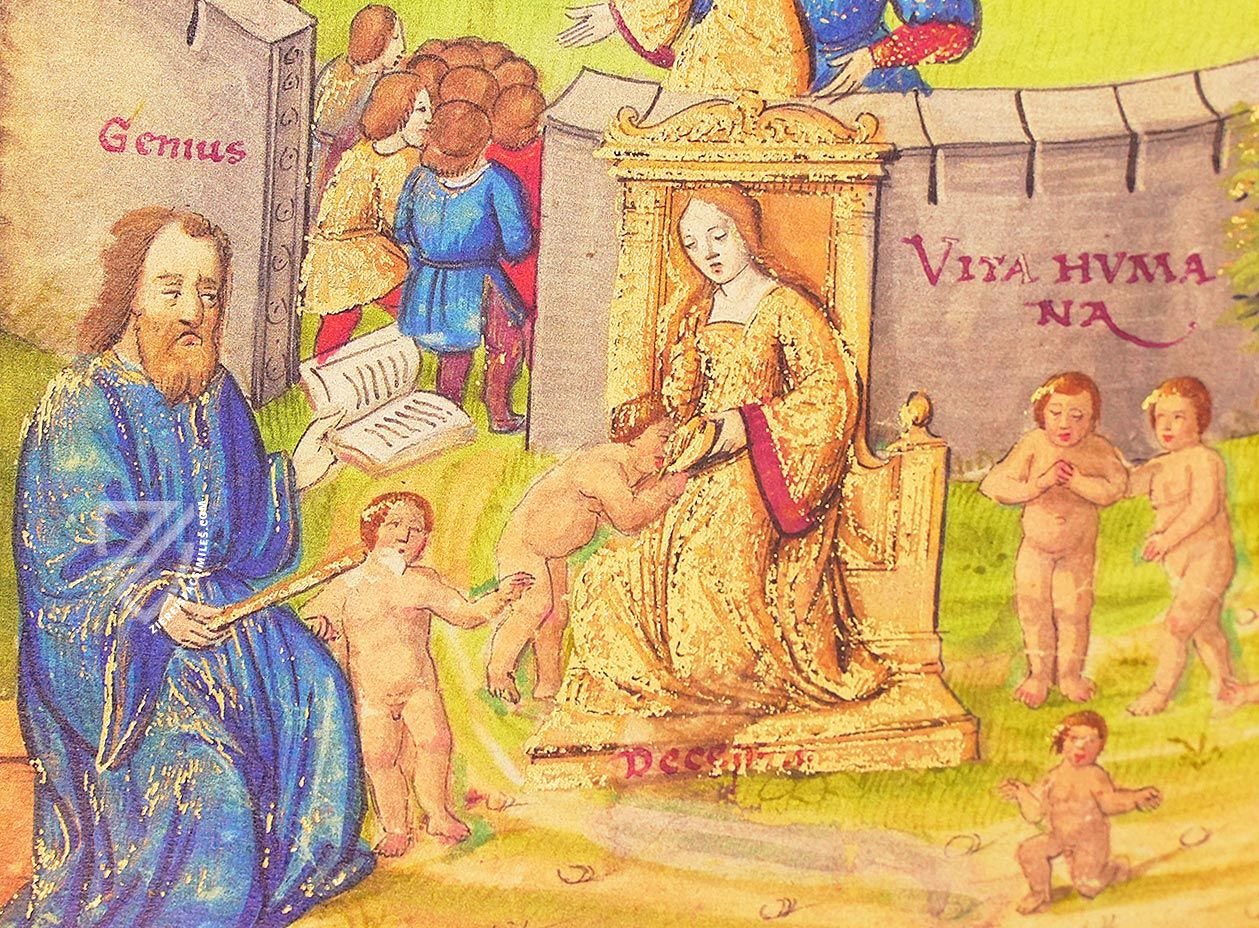
Tabula of Cebes
The Seat of Virtue
Personified by an enthroned allegory with a book and sword, the Seat of Virtue is located in the Garden of Bliss. She is flanked by Aeternitas and Gloria. The three figures are turned towards the viewer and - in accordance with the text - invite them to search for them and to align their own life with finding bliss.
Accordingly, the garden is reminiscent of Christian paradise iconography such as the Hortus Conclusus and the Garden of Paradise, in which otherwise one encounters the Virgin Mary and/or a unicorn. The flower meadow is enclosed by a hedge of blooming rose bushes and a marble balustrade. The entrance in the form of a rose arch is guarded by Studius and Mars.
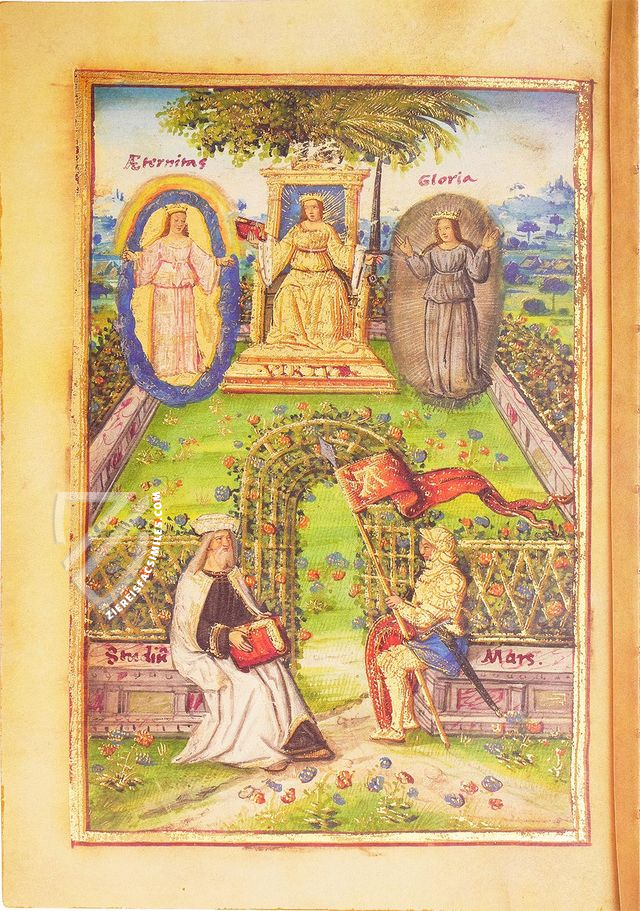
#1 Le Tavole della Saggezza e della Virtù
Language: German
#2 Le Tavole della Saggezza e della Virtù
Language: Italian
- Treatises / Secular Books
- Apocalypses / Beatus
- Astronomy / Astrology
- Bestiaries
- Bibles / Gospels
- Chronicles / History / Law
- Geography / Maps
- Saints' Lives
- Islam / Oriental
- Judaism / Hebrew
- Single Leaf Collections
- Leonardo da Vinci
- Literature / Poetry
- Liturgical Manuscripts
- Medicine / Botany / Alchemy
- Music
- Mythology / Prophecies
- Psalters
- Other Religious Books
- Games / Hunting
- Private Devotion Books
- Other Genres
- Afghanistan
- Armenia
- Austria
- Belgium
- Belize
- Bosnia and Herzegovina
- China
- Colombia
- Costa Rica
- Croatia
- Cyprus
- Czech Republic
- Denmark
- Egypt
- El Salvador
- Ethiopia
- France
- Germany
- Greece
- Guatemala
- Honduras
- Hungary
- India
- Iran
- Iraq
- Israel
- Italy
- Japan
- Jordan
- Kazakhstan
- Kyrgyzstan
- Lebanon
- Liechtenstein
- Luxembourg
- Mexico
- Morocco
- Netherlands
- Palestine
- Panama
- Peru
- Poland
- Portugal
- Romania
- Russia
- Serbia
- Spain
- Sri Lanka
- Sweden
- Switzerland
- Syria
- Tajikistan
- Turkey
- Turkmenistan
- Ukraine
- United Kingdom
- United States
- Uzbekistan
- Vatican City
- A. Oosthoek, van Holkema & Warendorf
- Aboca Museum
- Ajuntament de Valencia
- Akademie Verlag
- Akademische Druck- u. Verlagsanstalt (ADEVA)
- Aldo Ausilio Editore - Bottega d’Erasmo
- Alecto Historical Editions
- Alkuin Verlag
- Almqvist & Wiksell
- Amilcare Pizzi
- Andreas & Andreas Verlagsbuchhandlung
- Archa 90
- Archiv Verlag
- Archivi Edizioni
- Arnold Verlag
- ARS
- Ars Magna
- ArtCodex
- AyN Ediciones
- Azimuth Editions
- Badenia Verlag
- Bärenreiter-Verlag
- Belser Verlag
- Belser Verlag / WK Wertkontor
- Benziger Verlag
- Bernardinum Wydawnictwo
- BiblioGemma
- Biblioteca Apostolica Vaticana (Vaticanstadt, Vaticanstadt)
- Bibliotheca Palatina Faksimile Verlag
- Bibliotheca Rara
- Boydell & Brewer
- Bramante Edizioni
- Bredius Genootschap
- Brepols Publishers
- British Library
- C. Weckesser
- Caixa Catalunya
- Canesi
- CAPSA, Ars Scriptoria
- Caratzas Brothers, Publishers
- Carus Verlag
- Casamassima Libri
- Centrum Cartographie Verlag GmbH
- Chavane Verlag
- Christian Brandstätter Verlag
- Circulo Cientifico
- Club Bibliófilo Versol
- Club du Livre
- CM Editores
- Collegium Graphicum
- Collezione Apocrifa Da Vinci
- Comissão Nacional para as Comemorações dos Descobrimentos Portugueses
- Coron Verlag
- Corvina
- CTHS
- D. S. Brewer
- Damon
- De Agostini/UTET
- De Nederlandsche Boekhandel
- De Schutter
- Deuschle & Stemmle
- Deutscher Verlag für Kunstwissenschaft
- DIAMM
- Droz
- E. Schreiber Graphische Kunstanstalten
- Ediciones Boreal
- Ediciones Grial
- Ediclube
- Edições Inapa
- Edilan
- Editalia
- Edition Deuschle
- Edition Georg Popp
- Edition Leipzig
- Edition Libri Illustri
- Editiones Reales Sitios S. L.
- Éditions de l'Oiseau Lyre
- Editions Medicina Rara
- Editorial Casariego
- Editorial Mintzoa
- Editrice Antenore
- Editrice Velar
- Edizioni Edison
- Egeria, S.L.
- Eikon Editores
- Electa
- Emery Walker Limited
- Enciclopèdia Catalana
- Eos-Verlag
- Ephesus Publishing
- Ernst Battenberg
- Eugrammia Press
- Extraordinary Editions
- Fackelverlag
- Facsimila Art & Edition
- Facsimile Editions Ltd.
- Facsimilia Art & Edition Ebert KG
- Faksimile Verlag
- Feuermann Verlag
- Folger Shakespeare Library
- Franco Cosimo Panini Editore
- Friedrich Wittig Verlag
- Fundación Hullera Vasco-Leonesa
- G. Braziller
- Gabriele Mazzotta Editore
- Gebr. Mann Verlag
- Gesellschaft für graphische Industrie
- Getty Research Institute
- Giovanni Domenico de Rossi
- Giunti Editore
- Graffiti
- Grafica European Center of Fine Arts
- Guido Pressler
- Guillermo Blazquez
- Gustav Kiepenheuer
- H. N. Abrams
- Harrassowitz
- Harvard University Press
- Helikon
- Hendrickson Publishers
- Henning Oppermann
- Herder Verlag
- Hes & De Graaf Publishers
- Hoepli
- Holbein-Verlag
- Houghton Library
- Hugo Schmidt Verlag
- Idion Verlag
- Il Bulino, edizioni d'arte
- ILte
- Imago
- Insel Verlag
- Insel-Verlag Anton Kippenberger
- Instituto de Estudios Altoaragoneses
- Instituto Nacional de Antropología e Historia
- Introligatornia Budnik Jerzy
- Istituto dell'Enciclopedia Italiana - Treccani
- Istituto Ellenico di Studi Bizantini e Postbizantini
- Istituto Geografico De Agostini
- Istituto Poligrafico e Zecca dello Stato
- Italarte Art Establishments
- Jan Thorbecke Verlag
- Johnson Reprint Corporation
- Josef Stocker
- Josef Stocker-Schmid
- Jugoslavija
- Karl W. Hiersemann
- Kasper Straube
- Kaydeda Ediciones
- Kindler Verlag / Coron Verlag
- Kodansha International Ltd.
- Konrad Kölbl Verlag
- Kurt Wolff Verlag
- La Liberia dello Stato
- La Linea Editrice
- La Meta Editore
- Lambert Schneider
- Landeskreditbank Baden-Württemberg
- Leo S. Olschki
- Les Incunables
- Liber Artis
- Library of Congress
- Libreria Musicale Italiana
- Lichtdruck
- Lito Immagine Editore
- Lumen Artis
- Lund Humphries
- M. Moleiro Editor
- Maison des Sciences de l'homme et de la société de Poitiers
- Manuscriptum
- Martinus Nijhoff
- Maruzen-Yushodo Co. Ltd.
- MASA
- Massada Publishers
- McGraw-Hill
- Metropolitan Museum of Art
- Militos
- Millennium Liber
- Müller & Schindler
- Nahar - Stavit
- Nahar and Steimatzky
- National Library of Wales
- Neri Pozza
- Nova Charta
- Oceanum Verlag
- Odeon
- Orbis Mediaevalis
- Orbis Pictus
- Österreichische Staatsdruckerei
- Oxford University Press
- Pageant Books
- Parzellers Buchverlag
- Patrimonio Ediciones
- Pattloch Verlag
- PIAF
- Pieper Verlag
- Plon-Nourrit et cie
- Poligrafiche Bolis
- Presses Universitaires de Strasbourg
- Prestel Verlag
- Princeton University Press
- Prisma Verlag
- Priuli & Verlucca, editori
- Pro Sport Verlag
- Propyläen Verlag
- Pytheas Books
- Quaternio Verlag Luzern
- Reales Sitios
- Recht-Verlag
- Reichert Verlag
- Reichsdruckerei
- Reprint Verlag
- Riehn & Reusch
- Roberto Vattori Editore
- Rosenkilde and Bagger
- Roxburghe Club
- Salerno Editrice
- Saltellus Press
- Sandoz
- Sarajevo Svjetlost
- Schöck ArtPrint Kft.
- Schulsinger Brothers
- Scolar Press
- Scrinium
- Scripta Maneant
- Scriptorium
- Shazar
- Siloé, arte y bibliofilia
- SISMEL - Edizioni del Galluzzo
- Sociedad Mexicana de Antropología
- Société des Bibliophiles & Iconophiles de Belgique
- Soncin Publishing
- Sorli Ediciones
- Stainer and Bell
- Studer
- Styria Verlag
- Sumptibus Pragopress
- Szegedi Tudomànyegyetem
- Taberna Libraria
- Tarshish Books
- Taschen
- Tempus Libri
- Testimonio Compañía Editorial
- Thames and Hudson
- The Clear Vue Publishing Partnership Limited
- The Facsimile Codex
- The Folio Society
- The Marquess of Normanby
- The Richard III and Yorkist History Trust
- Tip.Le.Co
- TouchArt
- TREC Publishing House
- TRI Publishing Co.
- Trident Editore
- Tuliba Collection
- Typis Regiae Officinae Polygraphicae
- Union Verlag Berlin
- Universidad de Granada
- University of California Press
- University of Chicago Press
- Urs Graf
- Vallecchi
- Van Wijnen
- VCH, Acta Humaniora
- VDI Verlag
- VEB Deutscher Verlag für Musik
- Verlag Anton Pustet / Andreas Verlag
- Verlag Bibliophile Drucke Josef Stocker
- Verlag der Münchner Drucke
- Verlag für Regionalgeschichte
- Verlag Styria
- Vicent Garcia Editores
- W. Turnowski Ltd.
- W. Turnowsky
- Waanders Printers
- Wiener Mechitharisten-Congregation (Wien, Österreich)
- Wissenschaftliche Buchgesellschaft
- Wissenschaftliche Verlagsgesellschaft
- Wydawnictwo Dolnoslaskie
- Xuntanza Editorial
- Zakład Narodowy
- Zollikofer AG

